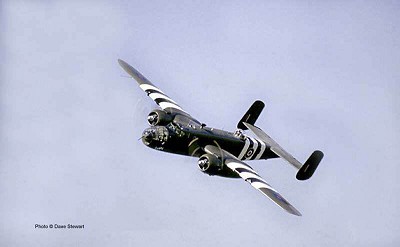ALL AIRCRAFT FLOWN
(Last Updated: 12.12.07)
Overview
This table below shows the different types of aircraft that Ken flew during his time in the RAF. I have used his Log-book entries of flying time in order to establish the total flying time in each type. A visitor to this site (Robert Stitt) has commented on how much trouble Ken had gone to in order to include both the serial number and the aircraft code letter, typically most pilots only used one or the other.
Aircraft
Miles Magister
Airspeed Oxford
Avro Anson
Lockheed Hudson
Armstrong Whitworth Whitley
Boeing Flying Fortress
Consolidated Liberator
De Havilland Dominie
Vickers Wellington
North American Mitchell
Number of Flights
84
123
57
246
2
118
38
2
1
11
Flying Time
49hrs 25 mins
69hrs 10 mins
115hrs 55 mins
563hrs 0 mins
3hrs 20 mins
534hrs 20 mins
64hrs 55 mins
2hrs 30 mins
2hrs 35 mins
13hrs 55 mins
This information equates to the following statistics:
Total Number of Flights = 682
Total Flying Time = 1,419 Hours & 5 Minutes
That's the equivalent of 59 days spent in the air flying!!
93% of all flying time was spent as a Pilot
The following sets of information against each aircraft flown by Ken have been gathered through various sources.
Miles Magister
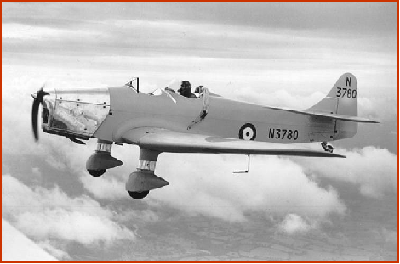
This plane was used as an RAF training aircraft that had a crew of 2. Ken is first recorded flying one on the 7th of August 1940, this was initially as a pupil and then completed his first solo flight as early as the 14th of August 1940. The last recorded main flight was on the 11th of September 1940 but it was used occasionally afterwards i.e. 22nd September 1941.
Country of Origin
Length
Height
Weight
Wing Span
Maximim Speed
Service Ceiling
Great Britain
24 ft 7 inches
6 ft 8 inches
1,286 pounds
33 ft 10 inches
132 mph
18,000 ft
Airspeed Oxford

This plane was primarily a navigational training aircraft, it was know as the 'Ox-Box' and had a crew of 3. Ken is first recorded flying this on the 15th of September 1940, again intially as a pupil with his first solo flight on the 20th of September 1940. The last recorded flight was on the 12th of December 1940.

This plane was primarily a trainer aircraft but was used as a light bomber and coastal patrol, it had a crew of 3. Ken is first recorded flying one on the 12th of February 1941 to complete a navigation exercise. The last recorded main flight was on the 21st of March 1941 however it was used occasionally afterwards for navigational exercises between the 15th of March 1944 and the 23rd of November 1944.
Country of Origin
Length
Height
Weight
Wing Span
Maximim Speed
Service Ceiling
Great Britain
42 ft 3 inches
13 ft 2 inches
5,880 pounds
56 ft 6 inches
188 mph
16,200 ft
Lockheed Hudson

The Hudson was used as a patrol aircraft as it was useful against German Submarines, it had a crew of 5. Ken is first recorded flying one on the 18th of June 1941, this involved night flying, high and low level bombing throughout August 1941. There were also escorts and convoy missions with a notable one on the 2nd of November 1941 which was an escort to the 'Secret Force'. The last recorded flight was on the 4th of August 1942.
Country of Origin
Length
Height
Weight
Wing Span
Maximim Speed
Service Ceiling
USA
44 ft 5 inches
11 ft 9 inches
11,645 pounds
65 ft 7 inches
246 mph
25,065 ftA
Armstrong Whitworth Whitley
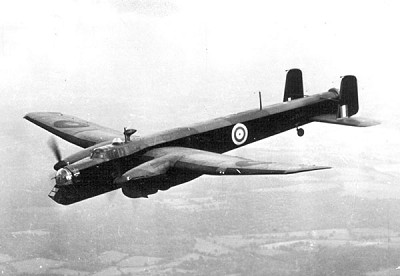
This plane was a heavy bomber with which Coastal Command sank the 1st German U-Boat, it had a crew of 5. Ken is first recorded flying one on the 29th of November 1941 with only one other recorded flight that was on the 28th of April 1942.
Country of Origin
Length
Height
Weight
Wing Span
Maximim Speed
Service Ceiling
Great Britain
70 ft 6 inches
15 ft
19,330 pounds
84 ft
222 mph
21,000 ft
Boeing Flying Fortress

This plane was a heavy bomber that sustained the majority of bombings between 1943 and 1945 and had a crew of 8. Ken is first recorded flying one on the 5th of August 1942, it was recorded as having upto 16 passengers on board at times. There was a lot of night flying done in the Fortress with many records of escort missions. The last recorded flight was on the 3rd of August 1943. There were 3 main types of Fortress, they were Fortress I's, Fortress II's and the Fortress IIA's...
The Fortress I was the RAF version of the B-17C of which a handful were used in 206 Squadron as trainer aircrafts ready for the Fortress IIA's. Prior to the 206 they were with 220 Squadron as trainers and a couple were used in Op's. The Fortress I's had markings like AN519, AN520. I have recently checked Ken's log-book and he flew in AN520 on January 1943 that was piloted by Squadron Leader Patrick.
The Fortress IIA was the RAF version of the B-17E of which there were 45 aircraft with markings of (FK184 to FK213) and (FL449 to FL460) and (FL462 to FL464). Ken flew in 14 of those 45 different aircrafts - 8 different FK aircraft and in 6 different FL aircraft.
The Fortress II was the RAF version of the B-17F of which there were 19 aircraft with markings of FA695 to FA713. Ken flew in 4 of the 19 different FA aircraft. The main external differences were the nose cone, on the Fortress II it had a one piece blown Perspex nose cone and broader propeller blades.
Thanks to Robert Stitt for this information
Country of Origin
Length
Height
Weight
Wing Span
Maximim Speed
Service Ceiling
USA
74 ft 6 inches
19 ft 2 inches
36,183 pounds
104 ft 1 inches
287 mph
35,526 ft
De Havilland Dominie
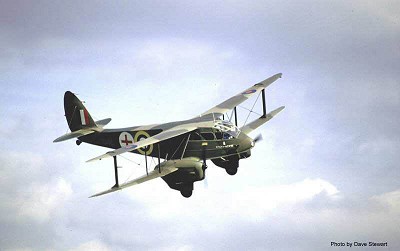
This plane was used for communications, transport and training that had a crew of 2. Ken is first recorded flying one on the 15th of August 1943 with the 206 Squadron, Group 15. There are only 2 recorded flights in the Dominie and they were both on the same day.
Country of Origin
Length
Height
Weight
Wing Span
Maximim Speed
Service Ceiling
Great Britain
34 ft 6 inches
10 ft 3 inches
3,230 pounds
48 ft
157 mph
19,500 ft
Vickers Wellington
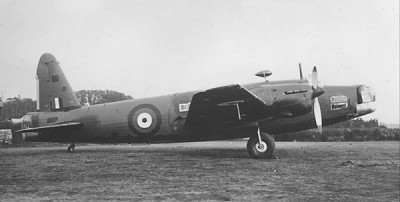
This plane was a heavy bomber that was known in the RAF as 'Wimpy'. It could do everything i.e. coastal guard, bombing, reconnaissance and patrol. It had a crew of 6. Ken is only recorded as flying the Wellington once and that was on the 6th of November 1943 for a navigational exercise.
Country of Origin
Length
Height
Weight
Wing Span
Maximim Speed
Service Ceiling
Great Britain
61 ft
17 ft 5 inches
18,581 pounds
86 ft 4 inches
255 mph
19,046 ft
Consolidated Liberator
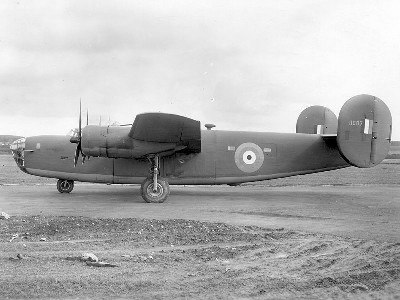
This plane was a heavy bomber that was known for its fuel capacity as it had a long range. It had a crew of 10. Ken is first recorded flying one on the 10th of December 1942, it was mainly used through April and May 1945 with 37 flights recorded. The last recorded main flight was on the 10th of May 1945, on the 17th of May 1945 Ken's summary of bombing contained the words
'keen and co-operative'.

Country of Origin
Length
Height
Weight
Wing Span
Maximim Speed
Service Ceiling
USA
67 ft 4 inches
18 ft 1 inches
36,547 pounds
110 ft 4 inches
290 mph
28,075 ft
North American Mitchell
